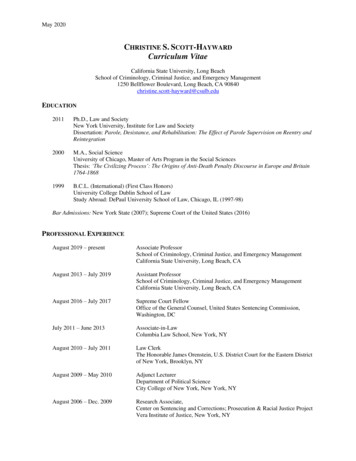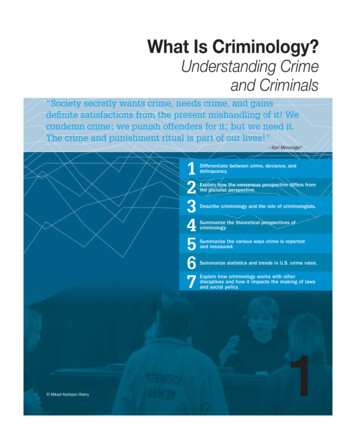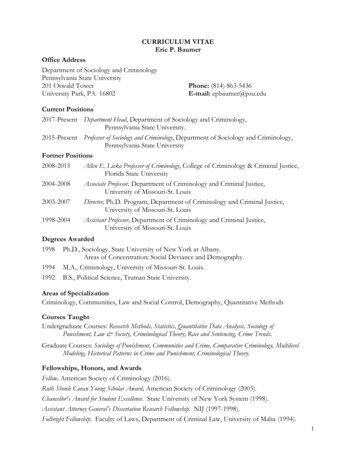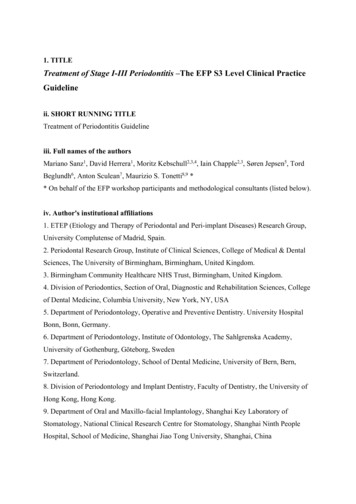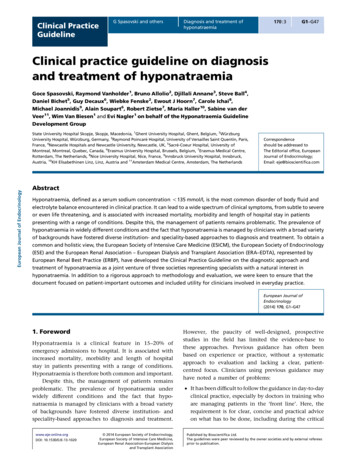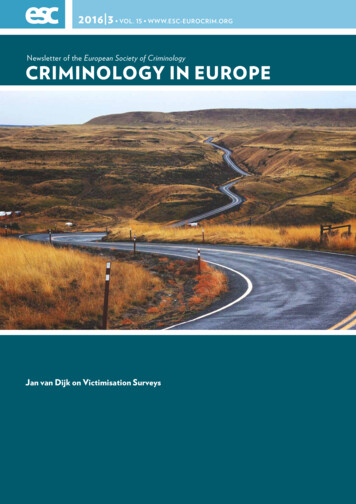
Transcription
2016 3 VOL. www.esc-eurocrim.orgNewsletter of the European Society of CriminologyCriminology in EuropeJan van Dijk on Victimisation Surveys
Message from the presidentRossella Selmini VOL. Criminology in Europe is published by theEuropean Society of Criminology.Web www.escnewsletter.orgEditor Csaba GyŐryEditorial office:Max Planck Institute for Foreign andInternational Criminal LawGünterstalstrasse 7379100 Freiburg i. Br.Phone: 49 (761) 7081-314Fax: 49 (761) 7081-294Email: c.gyoery@mpicc.deThe European Society of Criminology is ascientific institution founded under the Literaryand Scientific Institutions Act 1854, a statute ofthe Parliament of the United Kingdom.President Rosella SelminiPresident-Elect Gorazd MeskoPast President Frieder DünkelExecutive Secretary MARCELO AEBIJournal Editor Paul KnepperNewsletter Editor Csaba GyőryMember Anna-Maria GetošMember LETIZIA PAOLIMember José Angel BrandarizMember KLAUS BOERS(organiser of the 2016 meeting)Member Michael Levi(organiser of the 2017 meeting)Communications should be addressed as followsTo the president:University of MinnesotaSociology Department1078 Social Science Bldg267 19th Ave SouthMinneapolis, MN 55455Email: rselmini@umn.eduTo the business office:University of LausanneESC-ICDP-Sorge-BCHCH-1015 Lausanne, SwitzerlandPhone: 41 21 692 4638Fax: 41 21 692 4645Email: secretariat@esc-eurocrim.orgISSN 1729-8164For advertising and marketing queries,including advertising on the Newsletter website, please contact the editor.Cover picture: pixabay/Unsplash2criminology in EUROPE Reflections on the Burqiniand Punitiveness in EuropeA year ago, when I was a candidateto become President of the ESC ,I wrote in this newsletter that one ofmy current research interests — andone of my concerns as a citizen andas a woman — was the increasing useof civil and administrative ordinancesto criminalise statuses, behaviours,and situations in urban spaces. Recent efforts to forbid Muslim womento wear burqinis on European beaches vividly demonstrate the dangersand problems.In recent years, many Europeancountries have enacted laws andrules that authorise local institutions,usually — at least in continental Europe — mayors, to issue ordinances that prohibit and punish behaviours. Theunderlying assumptions are that the behaviours are potentially dangerous and‘criminogenic’, even if not criminal in themselves. Examples include the wellknown Anti-Social Behaviour Orders in England and Wales in the first decadeof the 2000s; the Italian ‘ordinanze amministrative’, the Spanish ‘ordenanzasde civisme’, and the French ‘Arretés municipaux’. These are not fundamentallydifferent from ‘civility laws’ and banishment orders in US cities.A recent special issue of the European Journal of Criminology on ‘The Renaissance of Administrative Orders and the Changing Face of Urban SocialControl’, which Adam Crawford and I edited, puts these regulations into comparative perspective. The articles pay attention to inter-connections betweendifferent types of administrative orders and the challenges they collectivelypresent to established theory, research, and practice. National case studiesreport on developments in England and Wales, France, Spain, Italy, Belgium,and the United States.The articles demonstrate that these new administrative orders and ordinances in Europe and the United States often target women’s rights; stigmatise immigrants and undermine their chances for integration; and banish or indiverse ways make life harder for marginal social groups and young people. Inmany cases the orders substantially or potentially increase control and punitiveness in our societies and reinforce penal populism.There is, of course, a great difference between Anglo — American laws andregulations and continental European administrative rules in terms of theirlegal nature, their enforcement, and their penal consequences. Despite thesedifferences, however, these measures share some relevant common features.First, they are part of a broader tendency to increase the regulation ofsocial problems and various forms of disorder at the urban level by increasing
state controls and increasing the possibility of criminalsanctions. Political discourses everywhere present theorders as more effective (and faster) alternatives tocriminal procedures. In practice, the result, as manystudies have shown, is to increase the role and thestrength of traditional, authoritative criminal justicemeasures. The orders are often welcomed by the punitive popular culture that they embody and are stronglysupported by governments and political cultures that,in many European countries, are shifting towards morepunitive approaches.Second, they are everywhere characterised by ‘legalhybridity’, which is described well by Katherine Beckettand Steve Herbert in their seminal 2010 book, Banished:The New Social Control in America. These orders arehybrids because they are mostly grounded in civil oradministrative powers on their face, but their violationfrequently results in criminal sanction (always in theAnglo-American systems, but only sometimes in thecontinental European systems). This mechanism is welldescribed by Andrew Simester and Andreas von Hirschas ‘two-step criminalisation’.These orders interact with criminal measures in different ways. They criminalise behaviours that were onceconsidered only to be social problems or disorders, butthat now are considered to be ‘undesirable’ features ofurban life. In effect, they also re-criminalise behaviours,such as begging and prostitution, that had been decriminalised in many countries. They increase the stopand search powers of the police, and they anticipatefuture criminalisation through the criminal laws. In allthese ways, the new orders do not result in fewer criminaljustice measures, but in more criminal regulations andincreased punitiveness.Third, and not surprisingly, they suffer from an ‘expansion syndrome’ that broadens the ‘targets’ of theseregulations in almost unlimited ways. The most commontargets are, everywhere, the same people and the samesituations: sex workers, homeless people, roma, immigrants, young people (and their ‘disturbing’ life-styles),children, and owners of animals.Extreme examples have become famous and are areason for criticism by the most liberal newspapers andcommentators. These include prohibitions on wearingsome kinds of dress—for example, short skirts or ‘weird’dresses in some Italian mayors’ orders—or putting up posters about lost cats, feeding wild animals, playing footballin the street, throwing rice during wedding ceremonies, ordecorating gardens with gnomes. Not rarely, this expansionin targeting behaviours goes hand in hand with a shift in3EUROPEAN SOCIETY OF CRIMINOLOGY regulation from public spaces to private spheres.This is the background of the ‘anti-burqini’ rules established last summer by some French mayors, with thesupport of prime minister Manuel Valls. The municipalorders that prohibited Muslim women from wearing theburqini on the French beaches attracted substantial attention and criticism, both within and outside of France.But it was not the first time that such orders were issued.It happened in Italy in 2008 when ‘anti-burqa’ and “antiburqini” ordinances were issued that constituted symbolic attacks on immigrants’ costumes, religious beliefs,and traditions.In practice, enforcement of these orders has been veryweak and they have been successfully challenged in administrative and criminal courts (as happened in France,finally, this summer). However, there are few doubts thatthey contribute to alarmist campaigns against ‘invasions’by immigrants from other countries and that they reinforce and increase anti-foreigner sentiment in Europeansocieties. This is not exactly what European societiesneed in these difficult times.The burqini cases — like the ‘anti-prostitution’ ordinances — do not raise issues only about legal rights and ethnicity. They are also on matters of gender in many differentways. They dictate what is ‘proper’ for a woman to wearand they establish the preeminence of the Western bikiniover a different bathing costume. We know from research on similar orders in Italy that they result in Muslimwomen withdrawing even more from public spaces thanthey otherwise would. Anti-prostitution orders have similar perverse effects; they make prostitutes more invisibleand more vulnerable, as fascinating ethnographic work inSpain by Carolina Villacampa demonstrates.That’s why I said, at the beginning of this message,that I am concerned as a criminologist, as a Europeancitizen, and as a woman.I believe that criminologists who want to play a criticalrole in society should engage in research and activism onthese issues and alert the scientific and political communities about the risks of over-reaching regulation ofpeople’s behaviour and ultimately of increasing criminalisation. As a citizen and as a woman, I think we shouldbe happy to see Muslim women bathing in the Mediterranean Sea, in whatever clothes they choose, rather thandying trying to cross it.Rossella Selmini is Professor of Criminology at the University of Minnesota Law School, Minnesota, USA , andthe President of the ESC .
Recipient of the ESC European Criminology AwardJan Van DijkIlluminating the Dark Figure of Crime:Victimisation Surveys and BeyondAcceptance speech at the award ceremony of theEuropean Criminology Award in Muenster, Germany,September Opening remarksBefore I say anything else, let me first thank the jury forits decision to bestow on me the European CriminologyAward for lifelong contribution to criminology in Europe. I have, as mentioned, received other professionalhonours, including the Sellin-Glueck and the StockholmCriminology Prize, but, indeed, for a European criminologist, the European Award is special.In particular, I want to thank Michael Tonry, the chairof this year’s jury, for his eloquently-drafted and personalised jury report, highlighting some of my achievements.And I want, of course, to wholeheartedly thank mycompatriot, Catrien Bijleveld, for her kind and flatteringwords on this happy occasion. Thank you all very much!It seems a sort of tradition for the winners of this awardto use this occasion to look back extensively at their professional careers. I hope you will agree with me that thiswould be inappropriate in my case. I am, as Michael justhinted, still far too young for such a retrospective. Ratherthan looking back, therefore, let me share with you someresults of ongoing research, and, tell you about my plansfor the future.Estimating the dark figure of crimeA constant feature of my criminological work has beenthe effort to estimate the true volume of crime. Thisstarted with my 1974 supervision of the first full-fledgednational victimisation survey in Europe, the LandelijkeSlachtofferenquete Misdrijven (National Crime Victimization Survey) of the Netherlands. This survey subsequently evolved into the International Crime Victims Survey(ICVS ), which has been carried out in over 80 countriesat least once since 1988 (Van Dijk, Van Kesteren & Mayhew, 2014).Why is it so important, one could ask, for governmentsto know how many crimes are actually committed againsttheir populations? First, crimes often inflict harm on ordinary people, and that could and ought to be prevented.Many, if not most, of these crimes are never recorded4criminology in EUROPE by the police, and victims of these ‘dark numbers’ areunlikely to be offered any kind of services or specialisedsupport. This, one could argue, is the basic victimological perspective on measuring the dark figure of criminalvictimisation.In addition, during my years at UNODC I have become convinced that organised crime, human trafficking,corruption and terrorism negatively impact the prosperity and welfare o
its decision to bestow on me the european Criminology award for lifelong contribution to criminology in eu-rope. I have, as mentioned, received other professional honours, including the sellin-Glueck and the stockholm Criminology Prize, but, indeed, for a european crimi-nologist, the european award is special.
